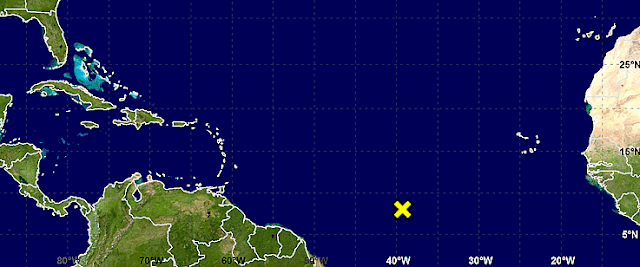Written by the TreasureGuide for the exclusive use of treasurebeachesreport.blogspot.com.
 |
| Hurricane Matthew Friday Morning Cone Source: nhc.noaa.gov |
By two AM Saturday Matthew is expected to have winds of over 110 mph. That is nothing to take lightly.
You can still see the northward turn that is predicted, taking it up near Jamaica and over Cuba.
The west edge of the cone is now touching Florida, at which time it is still shown as a hurricane.
Below are the surf predictions for the Fort Pierce area.
If this prediction is accurate, the surf will begin to increase Tuesday and reach a peak of up to ten feet on Wednesday. That is not just a one or two day bump either. Could actually do something for us, but I hope it stays to the east.
Keep watching.
---
Below are the surf predictions for the Fort Pierce area.
 |
| Source: MagicSeaWeed.com |
Keep watching.
---
People tend to think that you can't find virgin detecting sites anymore. That is partly because the virgin sites aren't the most obvious. You can't find them on every street corner. Because I do mostly beach hunting these days, with few exceptions, I hardly ever think about finding what other people might call a virgin site. I do think of detecting some out-of-the-way places or relatively unexplored places from time to time, but it is not much of an issue to me how many people might have been there before. There are a few reasons for that.
I am often surprised by how much is left to be found at sites that have been hunted and hunted. I also usually feel that there is some virgin ground even at most sites that have been heavily hunted. It might be a bit deeper, or masked by junk, or under bushes, or next to concrete or rebar, near power lines, or it might be beach sand that just got uncovered or that just got replenished in one way or another.
Take for example the Jupiter beach that I talked about the other day. That beach was hunted by Dave and others many times before I hunted it. It sure wasn't what you would call a virgin site by any stretch of the imagination, yet all of sudden it became very productive because of the erosion. Those coins had been there in the dunes waiting for a long time.
Every once in a while you get access to new layers of sand on a beach or new targets that wash out of the dunes or out of the water and onto the beach. Something similar happens on land sites. Areas get uncovered in one way or another.
Take for example, the old Indian and wagon trail that I hunt up in the hills of West Virginia. It has been hunting many times by others and myself, yet it still produces.
Just this year they had heavy rains there. It undoubtedly washed out parts of the trail as well as the cliffs beside the trail, and eroded gullies and hillsides. I can't wait to get up there again some time this Fall because I know I will have access to new virgin layers of soil and new targets. It doesn't matter if others have been there, I'll still find spots that have not been detected and feel like it is virgin ground all over again.
Happy hunting,
TreasureGuide@comcast.net



































